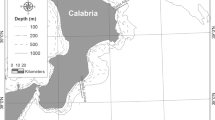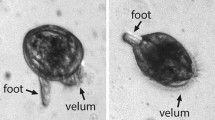Abstract
The six-rayed starfish Leptasterias hexactis (Stimpson, 1862) is seasonally exposed to low salinities in southeastern Alaska. Individuals that were gradually exposed to reduced salinities in the laboratory had a 28-d TLm of 12.9‰ S. The activity of L. hexactis, as measured by its activity coefficient, varied directly with salinity. Individual feeding rates of the starfish on similarly exposed Mytilus edulis, measured daily for 21 d at salinities of 30, 20 and 15‰ S, also varied directly with salinity. The dry weight of mussel tissue consumed was 8.84, 8.49 and 0.58 mg ·starfish-1·d-1 at 20, 20 and 15‰ S. Expressed as percent of dry starfish weight, the daily feeding rate was 1.35, 0.76 and 0.10% at 30, 20 and 15‰ S. Absorption efficiency decreased from 64% at 30‰ S to 49% at 20‰ S, further reducing the energy available for metabolism. Growth, measured in terms of changes in total dry weight or dry weight of soft tissues, also varied directly with salinity. Although exposure to hyposmotic conditions did induce stress responses, as indicated by reductions in activity, feeding, absorption efficiency and growth rates, L. hexactis maintained positive growth for at least a 3-wk period in the laboratory at 20‰ S and 13°CC. The population of L. hexactis investigated must be considered euryhaline and brief periods of exposure to hyposmotic conditions should not limit its distribution.
Similar content being viewed by others
Literature Cited
Barr, A. J., J. H. Goodnigt, J. P. Sall, W. H. Blair and D. M. Chilko: SAS user's guide, 1979 edition, 494 pp. Raleigh: SAS Institute, Inc. 1979
Bayne, B. L. and C. Scullard: Rates of feeding by Thais (Nucella) lapillus (L.). J. exp. mar. Biol. Ecol. 32, 113–129 (1978)
Binyon, J.: Salinity tolerance and permeability to water of the starfish Asterias rubens L. J. mar. biol. Ass. U.K. 41 161–174 (1961)
Bull, H. O.: Aquarium observations on the rate of growth and enemies of the common starfish Asterias rubens. Rep. Dove mar. Lab. Ser. 3, 2, 60–65 (1934)
Chia, F. S.: Systematics of the six-rayed starfish, Leptasterias, in the vicinity of San Juan Island, Washington. Syst. Zool. 15, 300–306 (1966a)
Chia, F. S.: Brooding behavior of a six-rayed startish, Leptasterias hexactis. Biol. Bull. mar. biol. Lab., Woods Hole 130, 304–315 (1966b)
Chia, F. S.: Histology of the pyloric cacca and its changes during brooding and starvation in a starfish, Leptasterias hexactis. Biol. Bull. mar. biol. Lab., Woods Hole 136, 185–192 (1969)
Christensen, A. M.: Feeding biology of the sea star Astropecten irregularis Pennant. Ophelia 8, 1–134 (1970)
Conover, R. J.: Assimilation of organic matter by zooplankton. Limnol. Oceanogr. 11, 338–354 (1966)
Doi, T.: Some aspects of feeding ecology of the sea stars, genus Astropecten. Publs. Amakusa mar. biol. Lab. 4, 1–19 (1976)
Ellington, W. R. and J. M. Lawrence: Coelomic fluid volume regulation and isosmotic intracellular regulation by Luidia clathrata (Echinodermata: Asteroidea) in response to hyposmotic stress. Biol. Bull. mar. biol. Lab., Woods Hole 146, 20–31 (1974)
Feder, H. M.: Natural history studies of the starfish Pisaster ochraceus (Brandt 1835) in the Monterey Bay area. Doctoral Dissertation Stanford Univ., 294 pp. 1956
Feder, H. M.: Growth and predation by the ochre sea star. Pisaster ochraceus (Brandt), in Monterey Bay, California. Ophelia 8, 161–185 (1970)
Feder, H. M. and A. M. Christensen: Aspects of asteroid biology. In: Physiology of Echinodermata, pp 87–127. Ed. by R. Boolootian. New York: John Wiley and Sons 1966
Fenchel, T.: Feeding biology of the sea star Luidia sarsi Duben and Koren. Ophelia 2, 223–236 (1965)
Finney, D. J.: Probit analysis, 33 pp. London: Cambridge Univ. Press 1971
Fisher, W. K.: Asteroidea of the North Pacific and adjacent waters. U.S. natl Mus. Bull. 76, 1–255 (1930)
Garton, D. and W. B. Stickle: Effects of salinity and temperature on the predation rate of Thais haemastoma on Crassostrea virginica spat. Biol. Bull. mar. biol. Lab., Woods Hole 158, 49–57 (1980)
Gezelius, G.: A daptation of the sea urchin Psammechinus miliaris to different salinities. Zool. Didr. Upps. 35, 329–337 (1963)
Halpern, J. A.: Growth rate of the tropical sea star Luidia senegalensis (Lamarck). Bull. mar. Sci. 20, 626–633 (1970)
Hatanaka, M. and M. Kosaka: Biological studies on the population of the starfish, Asterias amurenis, in Sendai Bay. Tohoku J. agric. Res. 4, 159–178 (1959)
Kleitman, N.: The effect of temperature on the righting of echinoderms. Biol. Bull. mar. biol. Lab., Woods Hole 80, 292–298 (1941)
Lange, R.: The osmotic adjustment in the echinoderm, Strongylocentrotus droebachiensis. Comp. Biochem. Physiol. 13, 205–216 (1964)
Lawrence, J. M.: The effect of temperature-salinity combinations on the functional well-being of adult Lytechnus variegatus (Lamarck) (Echinodermata, Echinoidea). J. exp. mar. Biol. Ecol. 18, 271–275 (1975)
Loosanoff, V. L.: Effects of sea water of reduced salinities upon starfish, A. forbesi, of Long Island Sound. Trans. Connecticut Acad. Arts. Sci. 36, 813–835 (1945)
McClintock, J. B. and J. M. Lawrence: An optimization study on the feeding behavior of Luidia clathrata Say (Echinodermata: Asteroidea). Mar. behav. Physiol. 7, 263–265 (1981)
Menge, B. A.: Foraging strategy of a starfish in relation to actual prey availability and environmental predictability. Ecol. Monogr. 42, 25–50 (1972a)
Merge, B. A.: Competition for food between two intertidal starfish species and its effect on body size and feeding. Ecology 53, 635–644 (1972b)
Menge, J. L. and B. A. Menge: Role of resource allocation, aggression and spatial heterogeneity in coexistence of two competing intertidal starfish. Ecol. Monogr. 44, 189–209 (1974)
Milligan, H. N.: Growth and regeneration in Solaster papposus. Zoologist Ser. 4 20, 469 (1916)
Morris, R. H., D. P. Abbott and E. C. Haderlie: Intertidal invertebrates of California, 690 pp. Stanford: Stanford Univ. Press 1980
Nimitz, M. A.: Histochemical study of gut nutrient reserves in relation to reproduction and nutrition in the sea stars, Pisaster ochraceus and Patiria miniata. Biol. Bull. mar. biol. Lab., Woods Hole 140, 461–481 (1971)
Paine, R. T.: Size-limited predation: an observational and experimental approach with the Mytilus-Pisaster interaction. Ecology 57, 858–873 (1976)
Paine, R. T.: Food webs: linkage, interaction strength and community infrastructure. J. Animal Ecol. 49, 667–685 (1980)
Pearse, J. S.: Coelomic water volume control in the Antarctic sea star Odontaster validus. Nature, Lond. 216, 1118–1119 (1967)
Percy, J. A.: Thermal adaptation in the boreo-arctic echinoid Strongylocentrotus droebachiensis (O. F. Muller, 1776). II. Seasonal acclimation and urchin activity. Physiol. Zool. 46, 129–138 (1973)
Polls, I. P. and J. J. Gonor: Behavioral aspects of righting in two asteroids from the Pacific coast of North America. Biol. Bull. mar. biol. Lab., Woods Hole 148, 68–84 (1975)
Ribi, G. and P. Jost: Feeding rate and duration of daily activity of Astropecten aranciacus (Echinodermata: Asteroidea) in relation to prey density. Mar. Biol. 45, 249–254 (1978)
Sabourin, T. D. and W. B. Stickle: Effects of salinity on respiration and nitrogen excretion in two species of echinoderms. Mar. Biol 65, 91–99 (1981)
Shirley, T. C. and W. B. Stickle: Responses of Leptasterias hexactis (Echinodermata: Asteroidea) to low salinity. II. Nitrogen metabolism, respiration and energy budget. Mar. Biol. 00, 00-00 (1982)
Sloan, N. A.: Aspects of the feeding biology of asteroids. Oceanogr. mar. biol. Ann. Rev. 18, 57–124 (1980)
Stancyk, S. E. and P. L. Shaffer: The salinity tolerance of Ophiothrix angulata (Say) (Echinodermata: Ophiuroidea) in latitudinally separate populations. J. exp. mar. Biol. Ecol. 29, 35–43 (1977)
Stickle, W. B. and R. Ahokas: The effects of tidal fluctuation of salinity on the perivisceral fluid composition of several echinoderms. Comp. Biochem. Physiol. 47A 469–476 (1974)
Stickle, W. B. and B. L. Bayne: Effects of temperature and salinity on oxygen consumption and nitrogen excretion in Thais lapillus. J. exp. mar. Biol. Ecol. 58, 1–17 (1982)
Stickle, W. B. and G. J. Denoux: Effects of in situ tidal salinity fluctuations on osmotic and ionic composition of body fluid in southeastern Alaska rocky intertidal fauna. Mar. Biol. 37, 125–135 (1976)
Turner, R. L. and C. E. Meyer: Salinity tolerance of the brackishwater echinoderm Ophiophragmus filograneus (Ophiuroidea). Mar. Ecol. Prog. Ser. 2, 249–256 (1980)
Vevers, H. G.: The biology of Asterias rubens L.: growth and reproduction. J. mar. biol. Ass. U.K. 28, 165–187 (1949)
Wood, L.: Physiological and ecological aspects of prey selection by the marine gastropod Urosalpinx cinerea (Prosobranchia: Muricidae). Malacologia 6, 267–320 (1968)
Yamaguchi, M.: Growth of juvenile Acanthaster planci (L.) in the laboratory. Pac. Sci. 28, 123–138 (1974)
Zachary, A. and D. S. Haven: Survival and activity of the oyster drill Urosalpinx cinerea under conditions of fluctuating salinity. Mar. Biol. 22, 45–52 (1973)
Author information
Authors and Affiliations
Additional information
Communicated by J. M. Lawrence, Tampa
Rights and permissions
About this article
Cite this article
Shirley, T.C., Stickle, W.B. Responses of Leptasterias hexactis (Echinodermata: Asteroidea) to low salinity. Mar. Biol. 69, 147–154 (1982). https://doi.org/10.1007/BF00396894
Accepted:
Issue Date:
DOI: https://doi.org/10.1007/BF00396894




